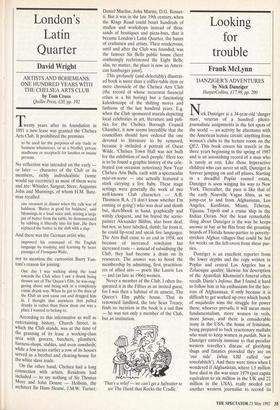London's Latin Quarter
David Wright
ARTISTS AND BOHEMIANS: ONE HUNDRED YEARS WITH THE CHELSEA ARTS CLUB by Tom Cross Quiller Press, £20, pp. 192 Twenty years after its foundation in 1891 a new lease was granted the Chelsea Arts Club. It prohibited the premises
to be used for the purposes of any trade or business whatsoever, or as a brothel, private madhouse or receptacle for lunatics or insane persons.
No reflection was intended on the early or later — character of the Club or its members, richly individualistic (some would say eccentric) as most of them were and are: Whistler, Sargent, Steer, Augustus John and Munnings, of whom H.M. Bate- man recalled
one occasion at dinner when the talk was of baldness. 'Butter is good for baldness', said Munnings in a loud voice and, seizing a large pat of butter from the table, he demonstrated by rubbing it liberally into his hair. He then replaced the butter in the dish with a slap.
And there was the German artist who
improved his command of the English language by studying and learning by heart passages of Finnegans Wake,
not to mention the cartoonist Barry Fan- toni's reason for joining:
One day I was walking along the road towards the Club when I saw a drunk being thrown out of The Queen's Elm, he was stag- gering about and being sick in a completely comic drunk way. When he got to the door of the Club an arm came out and dragged him in. I thought that anywhere that pulled drunks in rather than threw them out was a place I wanted to belong to.
According to this informative as well as entertaining history, Church Street, in which the Club stands, was at the time of the granting of its lease a working-class area with grocers, butchers, plumbers, harness-shops, stables, and even cowsheds; while a few years earlier a row of its houses served as a brothel and clearing-house for the white slave trade.
On the other hand, Chelsea had a long connection with artists. Residents had included — to say nothing of Sir Thomas More and John Donne — Holbein, the architect Sir Hans Sloane, J.M.W. Turner, Daniel Maclise, John Martin, D.G. Rosset- ti. But it was in the late 19th century, when the Kings Road could boast hundreds of studios and workshops instead of thou- sands of boutiques and pizza-bars, that it became London's Latin Quarter, the haunt of craftsmen and artists. Their rendezvous, until and after the Club was founded, was the famous Six Bells public house (here confusingly rechristened the Eight Bells; alas, no matter, the place is now an Ameri- can hamburger joint).
This profusely (and delectably) illustrat- ed book is more than a coffee-table item or mere chronicle of the Chelsea Arts Club (the record of whose recurrent financial crises is a bit boring) but a fascinating kaleidoscope of the shifting mores and fashions of the last hundred years. E.g. when the Club sponsored murals depicting local celebrities in art, literature and poli- tics for the Chelsea Borough Council Chamber, it now seems incredible that the councillors should have ordered the one devoted to literature to be removed, because it included a portrait of Oscar Wilde. `Chelsea Town Hall was not built for the exhibition of such people.' Here too is to be found a graphic history of the cele- brated (on occasion notorious) New Year Chelsea Arts Balls, each with a spectacular mire-en-scene — one actually featured a stork carrying a live baby. These stage settings were generally the work of two well-known Club characters — A.R. Thomson R.A. CI don't know whether I'm coming or going') who was deaf and dumb but, sketchbook in hand, graphically and wittily eloquent, and his friend the scene- painter Alexander Bilibin, also born deaf, but not, as here labelled, dumb; far from it, he could lip-read and speak five languages. The Arts Ball came to an end in 1958, not because of increased rowdyism but increased costs — instead of subsidising the Club, they had become a drain on its resources. The answer was to boost the membership by admitting, first, practition- ers of allied arts — poets like Laurie Lee — and (as late as 1966) women.
Never a member of the Club, I often fre- quented it in the Fifties as an invited guest, for I was then a habitué of its annexe, The Queen's Elm public house. That its renowned landlord, the late Sean Treacy, finds no mention in the book is a sad flaw — he was not only a member of the Club, but an institution.
'That's a relief — we can't get a babysitter to see The Hand that Rocks the Cradle.'


































































 Previous page
Previous page